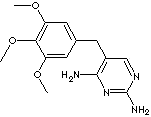| CAS
NO. |
738-70-5 |

|
| EINECS NO. |
212-006-2 |
| FORMULA |
C14H18N4O3 |
| MOL
WT. |
290.32 |
|
H.S.
CODE
|
|
|
TOXICITY
|
|
| SYNONYMS |
Chemotrim; Idotrim;
|
| Monotrim; Primosept;
Primsol; Proloprim; 2,4-Diamino-5-(3,4,5-trimethoxybenzyl)pyrimidine;
Lidaprim; Methoprim;
5-((3,4,5-Trimethoxyphenyl)methyl)-2,4-pyrimidinediamine; Syraprim; Tiempe; TMP-Ratiopharm; Trimanyl; Trimethoprim;
Trimexazole; Trimogal; Trimetoprima;
5-(3,4,5-trimetoxibencil)pirimidina-2,4-diamina (Spanish); Triméthoprime;
5-(3,4,5-triméthoxybenzyl)pyrimidine-2,4-diamine (French); 5-(3,4,5-Trimethoxybenzyl)-2,4-
DiaminoPyrimidine;
5-(3,4,5-Trimethoxybenzyl)
pyrimidin-2,4-diamin (German); |
| SMILES |
|
|
CLASSIFICATION
|
|
|
PHYSICAL AND CHEMICAL PROPERTIES
|
| PHYSICAL
STATE |
white to yellowish
powder |
| MELTING POINT |
199 - 203 C |
| BOILING
POINT |
|
| SPECIFIC GRAVITY |
|
| SOLUBILITY
IN WATER |
(Soluble in
DMSO) |
| pH |
|
| VAPOR DENSITY |
|
|
AUTOIGNITION
|
|
|
NFPA
RATINGS
|
|
|
REFRACTIVE
INDEX
|
|
| FLASH
POINT |
|
| STABILITY |
Stable
under ordinary conditions |
|
GENERAL
DESCRIPTION AND APPLICATIONS
|
|
Trimethoprim, an antibacterial drug, is a bacterial dihydrofolate reductase
inhibitor used as a prophylactic or to treat various bacterial infections
particularly urinary tract infections such as Proteus mirabilis, Escherichia
coli, and Klebsiella species as well as Pneumocystis carinii and traveler's
diarrhea. Folic acid is essential for hematopoiesis. It is reduced to
dihydrofolic acid and then tetrahydrofolic acid , the parent compound of the
derivatives that act as coenzyme carriers of one-carbon groups in various
metabolic reactions. In result, trimethoprim interferes the synthesis of
tetrahydrofolic acid resulting the inhibition of the DNA nucleoside synthesis.
It is usually used in combination with a sulfonamide drug, sulfamethoxazole for synergistic effect
(in the ratio 1:5). The molecular
structure of sulfonamide class antimicrobial agents is similar to p-Aminobenzoic
acid (PABA) which is needed in bacteria organisms as a substrate of the enzyme
dihydropteroate synthetase for the synthesis of tetrahydrofolic acid (THF).
Sulfonamides are capable of interfering with the metabolic processes in bacteria
that require PABA. The combination drug interferes with sequential steps in the
metabolism of certain bacteria. But the use of sulfamethoxazole is declining
due to reports of sulfamethoxazole bone marrow toxicity. The trade names of the
combined product are Bactrim and Septra. The chemical designation of
trimethoprim is 5-[(3, 4, 5-trimethoxyphenyl)methyl]-2, 4-pyrimidine diamine. It
is a white to yellowish compound with bitter taste. Sulfamethoxazole is
4-amino-N-(5-methyl-3-isoxazolyl) benzenesulfonamide or (N1-(5-methyl-3-Isoxazolyl) Sulfanilamide). It is an white to
off-white compound, odorless, tasteless. Dapsone (4,4'-sulfonylbisbenzenamine) is a parent compound in
preparing sulfonamide antibacterial agents such as acedapsone, acetosulfone,
glucosulfone, sulfoxone and solapsone. Dapsone and its derivatives have
bacteriostatic activity against a broad spectrum of gram-negative and
gram-positive organisms. Dapsone is a primary treatment for Dermatitis
herpetiformis and in the treatment of leprosy (Mycobacterium leprae infections)
leads to apparent improvementas. It is used in the prophylaxis of falciparum
malaria. It is a white crystalline powder; melting point 175 - 180C; insoluble
in water and vegetable oils. Pentamidine is also used for the patients who are
allergic to trimethoprim or sulfamethoxazole. Pentamidine is an antiprotozoal agent
used as the isethionate salt to preventi and treat diverse phylum of eukaryotic microorganisms. It is a nonpyrogenic, lyophilized product. Pentamidine
isethionate is a white crystalline powder; soluble in water and glycerin;
insoluble in ether, acetone, and chloroform. The chemical designation is 4,4'-
diamidino-diphenoxypentane di(beta-hydroxyethanesulfonate). |
| SALES
SPECIFICATION |
|
BP/EP/CP/USP
|
|
APPEARANCE
|
white to yellowish
powder |
|
ASSAY
|
99.0
- 101.0%
|
|
LOSS
ON DRYING
|
0.5%
max
|
|
RELATED
SUBSTANCE
|
0.2%
max
|
|
PARTICLE
SIZE
|
80
- 100 (mesh)
|
| TRANSPORTATION |
| PACKING |
25kgs
in fiber drum |
| HAZARD CLASS |
|
| UN
NO. |
|
| OTHER
INFORMATION |
|
Hazard
Symbols: T, Risk Phrases: 25, Safety Phrases: 45 |
